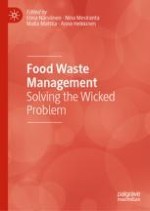Introduction
The Case for Insects—Why Bioconversion of Food Waste?
Waste-to-Insect Pairings
Species | Organic wastes | Country | Bioconversion output | Reference |
|---|---|---|---|---|
Black soldier fly
(Hermetia illucens) | Rice straw, restaurant waste (3:7) | China | Biofuel | Zheng, Hou, et al. (2012) |
Rice straw | Indonesia | Biomass | Manurung et al. (2016) | |
Coffee pulp, husk | El Salvador, Indonesia | Biomass, fertilizer | ||
Waste from pears, banana, and cucumber (5:3:2) | Sweden | Biomass | Mutafela (2015) | |
Corn stover | China | Biofuel, soil amendment | Wang et al. (2017) | |
Corncob | China | Biofuel | Li et al. (2015) | |
Sorghum | United States | Biomass | Tinder et al. (2017) | |
Cowpea | United States | Biomass | Tinder et al. (2017) | |
Cassava peel | Indonesia | Biomass | Supriyatna et al. (2016) | |
Vegetable trimmings, spent coffee grounds, and tea leaves | United States, Hong Kong | Biomass | Cheng (2016) | |
Vegetables, peels of yam, cassava, plantain | Ghana | Biomass | Bonso (2013) | |
Housefly
(Musca domestica) | Restaurant waste (70%) Corn silage, sawdust (30%) | China | Biomass, biofuel, fertilizer | Niu et al. (2017) |
Codling moth
(Cydia pomonella) | Starch and cheese wastewater sludge | Canada | Biomass | Brar et al. (2008) |
Cambodian field crickets (Teleogryllus testaceus) | Cassava plant tops, spent grain, mung bean sprout waste, field weeds | Cambodia | Biomass | Miech et al. (2016) |
Yellow Mealworm
(Tenebrio molitor) | Wheat straw, bruised cabbage leaves | China | Biomass | |
Corn stover | China | Biofuel | Wang et al. (2017) |
Selective Breeding
Business Processes
Company | Food waste eliminated | Daily reduction (estimate) | Insects used | Products sold | Country | Founded (year) |
|---|---|---|---|---|---|---|
Agriprotein
| Pre- and post-consumer organic waste | 72 Mg | Black soldier fly | Protein feed ingredient (MagMeal™), oil feed ingredient (MagOil™) and compost (MagSoil™) | South Africa | 2008 |
Nextalim
| 100% traceable EU approved by-products | 41 Mg | Black soldier fly | Insect fertilizer, black soldier fly larvae live or dried, black soldier fly larvae defatted proteins and BSF oil | France | 2013 |
Alapre
| Organic waste and animal by-products | 24 Mg | Black soldier fly | Insect meal and compost sold under the trademark “ENTHOS” | Colombia | 2014 |
Proti-farm
| Vegetable by-products | confidential | Lesser mealworm + various | Various applications with focus on food: buffalo’s frozen, freeze-dried, grinded (EntoPure) | Netherlands | 1978 |
Entofood
| 100% vegetal by-products | 240 kg | Black soldier fly | Whole insect meal, defatted insect meal, insect oil | Malaysia | 2012 |
Insectum
| Former foodstuff including milk and eggs | 22 kg | Black soldier fly | Black soldier fly larvae frozen, dried and/or defatted | Lithuania | 2016 |
Nextprotein
| Organic inconsumable food matter | 4.5 Mg | Black soldier fly | Insect protein meal, oil, and fertilizer | France/Tunisia | 2015 |
Hermetia
| Bruised rye | 4.3 Mg | Black soldier fly | Dried larvae, insect meal, insect oil, fertilizer | Germany | 2006 |
F4F
| Pre-consumer organic waste | 1.3 Mg | Black soldier fly | Starter feed functional ingredients (fish and poultry), exotic pet snacks, fertilizer and feed development trials | Chile | 2014 |
Innovafeed
| Cereal by-products | 1.1 Mg | Black soldier fly | Defatted meal and purified fat of black soldier fly larvae | France | 2015 |
Enterra feed
| Pre-consumer recycled food products | confidential | Black soldier fly | Whole dried larvae, meal, and oil | Canada | 2007 |
Ynsect
| Vegetal material only, like cereal by-products | confidential | Mealworm | Protein, oil, frass | France | 2011 |
